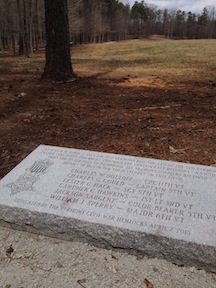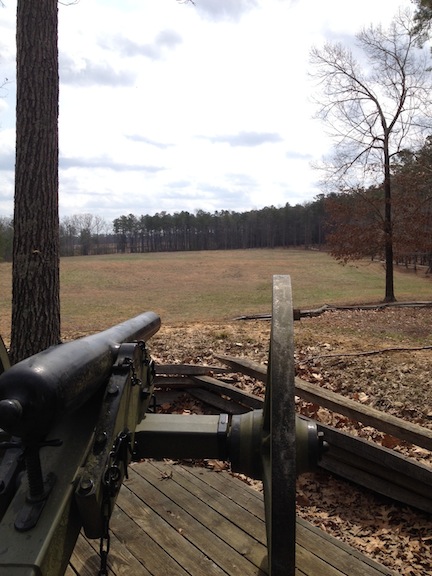Visiting Pamplin Park on the Road to Appomattox

For anyone following Lee’s retreat and Grant’s pursuit this week, be sure to start your run at Pamplin Park, where Federal troops first broke the Confederate line. While the anniversary of the breakthrough was April 2, it’s worth a stop at Pamplin to get a true understanding of the story.
With the anniversary a couple days passed, Edward Alexander is just now catching his breath. Edward’s new ECWS book Dawn of Victory: Breakthrough at Petersburg, March 25-April 2, 1865, recounts the story of the Federal “wedge that broke the Confederacy.” I got to hear the story in person, though, as Edward took some time over the weekend to show me around.
To students of the war, the trenches around Petersburg are no surprised—but it’s one thing to read about them and another to see them in person. Pamplin has even constructed a durable concrete-and-fiberglass model to give visitors a true sense of what the works once looked like.
The original works themselves, however, are stunning. I spend most of my time walking alongside small lines of mounded dirt in the Wilderness and at Spotsylvania. These works dwarf anything on my usual battlefields. The smaller works, of course, evolved over time into the massive fortifications the armies inhabited for nine months around Petersburg. It is awesome to behold the results of that evolution.

The park’s walking trails jump outside the Confederate line and extend to the advanced picket posts. Once obscured by brush, the line of rifle pits dots the high ground facing the Union line, a mile away. The trail also offers a look at ground the Civil War Trust recently cleared, showing the open attack plain Federals crossed from their position near Fort Welch, which is today part of Petersburg National Battlefield.
Inside Pamplin, an open field directly in front of the Confederate works sets the stage for the charge’s final thrust. Imagine charging over that gently undulating field, I wonder aloud. There’s a small swale where Vermonters gathered themselves for the last desperate leg of their assault. A new monument commemorating the actions of six Medal of Honor recipients sits on the field’s edge.

Edward soon has us up and into the works, as well. They are massive. That’s the word that keeps coming back to me: massive.
What it must have taken for those men to assault this position.
There were as many men in that charge as were in Lee’s fabled “Pickett’s Charge” at Gettysburg, and here the men charged a far, far more daunting position over ground every bit as open.
As strong as the position was, winter had weakened the Confederate army and stripped its ranks. Lee’s men, hardened as they were, crumbled—although not without stiff resistance.
Despite the Federal momentum, Lee’s men not only staved off total destruction, they were also able to get a head start on the roads westward. Dogged Federal pursuit would eventually run them to ground, but that has as much to do with the failure of the Confederacy’s infrastructure to supply Lee’s men in their flight as anything the Federals did. Logisitics failures led to Lee’s surrender at Appomattox as much as Grant did.
That’s the tale that unfolded this week, 150 years ago—and it’s a tale that started at Pamplin (and, unpacking the story even further, a story triggered at Five Forks on April 1, 1865).
Pamplin, which preserves 424 acres, sometimes gets unfair criticism because it charges admission, but as a privately owned park, it doesn’t get the Federal tax subsidies that National Parks do. It costs money to maintain and staff the park. The money, I see as I walk around, gets put to good use. The trails are clean and well-maintained. The facilities are gorgeous. The natural resources are well preserved. The interpretation is clear and understandable. In fact, Pamplin outshines a lot of parks I’ve visited, which are often underfunded and understaffed. (The sesquicentennial did a lot of shake loose some extra funding for the Park Service’s Civil War battlefields, but I shudder to think what will happen now that the 150th is wrapping up.)
Pamplin Park, which its National Museum of the Civil War Soldier, is definitely worth a stop this week on anyone’s road to Appomattox.

Sounds like a great visit to this excellent park. I’m a little jealous. 😉 I got to visit Pamplin about seven years ago, but unfortunately didn’t have time to hike and see the earthworks…hopefully, next time!